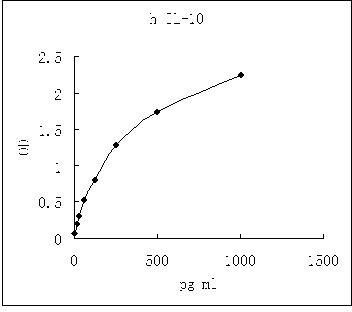Human IL-10 ELISA Kit (96-well)
USD 415.00
3 Weeks*
Specifications
| Product Data | |
| Format | 96-well strip plate |
| Assay Type | Solid Phase Sandwich ELISA |
| Assay Length | 3 hours |
| Signal | Colorimetric |
| Curve Range | 15.625-1000pg/ml |
| Sample Type | Cell culture supernatant, serum, plasma (EDTA, citrate, heparin) |
| Sample Volume | 20 uL |
| Specificity | Natural and recombinant Human IL-10 Ligand |
| Sensitivity | 7pg/mL |
| Reactivities | Human |
| Interference | No significant interference observed with available related molecules. |
| Components |
|
| Background | Interleukin 10 (IL-10), initially designated cytokine synthesis inhibitory factor (CSIF), was originally identified as a product of murine T helper 2 (TH2) clones that suppressed the production of cytokines by T helper 1 (TH1) clones responding to antigen stimulation in the presence of monocyte/macrophage antigen-presenting cells . The human homologue of mouse IL-10 was subsequently cloned by cross-hybridization . Human and mouse IL-10 are 81% and 73% identical at the nucleotide and amino acid levels, respectively. Mouse, rat and human IL-10 cDNAs encode 178 amino acid (aa) residue precursor polypeptides with hydrophobic signal peptides that are cleaved to generate 160 aa residue mature proteins. There is at least 73% aa identity between the proteins from the three species. In contrast to mouse IL-10, human IL-10 appears to be non-glycosylated. Both mouse and human IL-10 exist as non-covalently-linked homodimers in solution. Although human IL-10 is active on mouse cells, mouse IL-10 does not show species cross-reactivity on human cells. IL-10 is a pleiotropic cytokine that can exert either immunosuppressive or immunostimulatory effects on a variety of cell types. human IL-10 can inhibit monocyte/macrophage-dependent, antigen-stimulated cytokine synthesis by human PBMNC and NK cells . L-10 can inhibit production or function of a macrophage membrane-bound costimulator required for activation of T cells and NK cells. IL-10 is a potent modulator of monocyte/macrophage function. IL-10 also enhances the release of soluble TNF receptors and inhibits the expression of surface ICAM-1 and B7 . Finally, IL-10 has been reported to suppress the synthesis of superoxide anion plus reactive oxygen intermediates (ROI), and either inhibit or facilitate nitric oxide synthesis, depending on the time of exposure to activated macrophages . IL-10 has marked effects on B cells. IL-10 also has documented activity on endothelial cells, where it mimics IL-4 , and on thymocytes and mast cells, where it acts as a growth costimulator . |
| Gene Symbol | IL10 |
| Standard Curve |

Representative standard curve for IL-10 ELISA. IL-10 was diluted in serial two-fold steps in Sample Diluent.
|
Documents
{0} Product Review(s)
Be the first one to submit a review






























































































































































































































































 Germany
Germany
 Japan
Japan
 United Kingdom
United Kingdom
 China
China